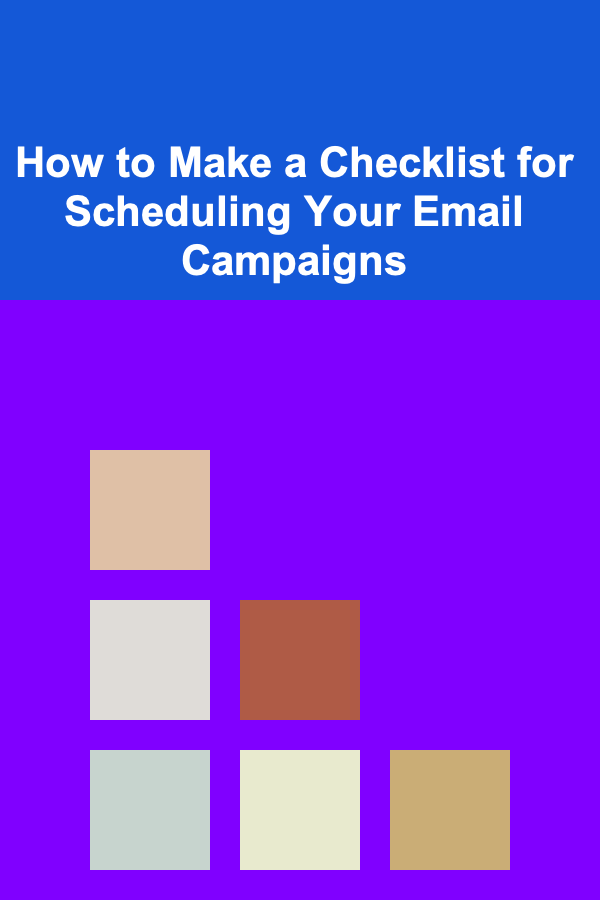
How to Make a Checklist for Scheduling Your Email Campaigns
ebook include PDF & Audio bundle (Micro Guide)
$12.99$5.99
Limited Time Offer! Order within the next:

Email marketing is one of the most effective ways to engage with your audience, build relationships, and drive conversions. However, despite its effectiveness, many businesses struggle to create and schedule email campaigns that deliver results. One of the key factors in successful email marketing is proper scheduling. Whether you're sending newsletters, promotional offers, or automated email sequences, having a well-structured checklist can help you stay organized and ensure your emails are sent at the optimal time for maximum impact.
This actionable guide will walk you through the steps to create a comprehensive checklist for scheduling your email campaigns. By following this guide, you'll be able to streamline your email marketing process, save time, and improve your campaign performance.
Understand the Importance of Scheduling in Email Campaigns
Before diving into creating a checklist, it's important to understand why scheduling your email campaigns is crucial. Proper scheduling allows you to:
- Maximize Open Rates: By sending emails at the right time, you increase the chances of your recipients seeing and opening your emails.
- Increase Engagement: Sending emails when your audience is most active can lead to higher engagement rates, including clicks, conversions, and interactions.
- Optimize Campaign Performance: A well-timed email campaign can significantly impact its success, leading to better sales, brand awareness, and customer retention.
With these benefits in mind, it's essential to create a structured process for scheduling your emails effectively.
Define the Purpose and Type of Your Email Campaign
The first step in creating your checklist is to define the purpose and type of your email campaign. Different campaigns may require different timing strategies. Here are some examples of common email campaign types and how they might affect your scheduling decisions:
- Newsletters: Often sent on a regular schedule (e.g., weekly, monthly). These emails typically provide updates, news, and content that keeps subscribers informed and engaged.
- Promotional Emails: These campaigns are usually time-sensitive and need to be scheduled around specific sales, events, or promotions.
- Transactional Emails: These emails are automatically triggered by actions (e.g., order confirmations, shipping updates). Their timing is less about strategic scheduling and more about sending them promptly.
- Drip Campaigns/Automated Sequences: These are a series of emails sent over time based on specific user actions or timelines. Scheduling for these emails is automated, but ensuring the proper sequence is crucial.
Actionable Tip:
Start by categorizing your email campaigns based on their purpose. This will help you determine the appropriate frequency and timing for each campaign type.
Know Your Audience and Time Zones
Understanding your audience is critical when it comes to scheduling your email campaigns. Different audiences have different habits, preferences, and time zones. What works for one demographic might not work for another.
Key Factors to Consider:
- Location: Your audience may be spread across different regions or countries. For example, if you're running a global campaign, you'll need to account for different time zones.
- Time of Day: People check their emails at various times depending on their profession, lifestyle, and personal habits. For instance, professionals might engage with emails during business hours, while others may be more active in the evening or on weekends.
- Device Usage: People open emails on various devices such as smartphones, tablets, and desktop computers. This can affect the time at which they interact with your content. For example, mobile users might be more likely to engage with emails during their commute.
Actionable Tip:
Use audience data (e.g., demographic information, past email engagement patterns) to determine the best time to send your campaigns. You can use email marketing software to segment your audience based on time zones and behavior.
Set Up a Campaign Calendar
One of the most effective ways to keep track of your email campaigns is by setting up a campaign calendar. A well-organized calendar helps you visualize the timing and frequency of your campaigns, ensuring you don't overlap or miss important dates.
How to Set Up Your Campaign Calendar:
- Choose a Frequency: Determine how often you want to send emails (e.g., daily, weekly, bi-weekly, monthly) based on the type of campaign and audience expectations.
- Avoid Over-Scheduling: Bombarding your audience with too many emails can lead to unsubscribes. Stick to a schedule that provides value without overwhelming your recipients.
- Factor in Holidays and Events: Schedule campaigns around holidays, seasonal events, and industry-related happenings. If you're running a promotional campaign, make sure it aligns with key sales events like Black Friday or Cyber Monday.
- Balance Promotional and Informational Content: Maintain a mix of content types to keep your audience engaged without being overly promotional.
Actionable Tip:
Create your campaign calendar in a shared platform like Google Calendar or a project management tool (e.g., Trello, Asana). This allows team members to collaborate and ensures everyone is on the same page.
Test Your Timing and Frequency
Once you have a basic schedule in place, it's time to test your email timings and frequency. No matter how much you think you know about your audience, there's no substitute for real-world testing. A/B testing is a powerful tool in determining the best time and frequency for your campaigns.
How to Test:
- Send Emails at Different Times: Use A/B testing to send emails at different times of the day and analyze which times result in higher open rates and engagement.
- Vary Frequency: Experiment with how often you send emails. For example, try sending a weekly newsletter versus a monthly one and compare the results.
- Use Metrics: Look at open rates, click-through rates, conversion rates, and unsubscribe rates to evaluate the performance of different sending times and frequencies.
Actionable Tip:
Most email marketing platforms allow you to set up A/B tests. Use this feature to test timing and frequency on small segments of your list, then scale the winning strategy to the rest of your audience.
Automate Your Scheduling
Email marketing automation tools have made it easier than ever to schedule and send campaigns at the optimal time. These tools allow you to set up emails in advance and have them sent automatically based on a predefined schedule.
Benefits of Email Automation:
- Save Time: Once your campaigns are set up, automation reduces the need for manual intervention.
- Consistency: Automation ensures that your emails are sent on time, every time, without any delays or mistakes.
- Personalization: Advanced automation tools allow you to send personalized emails based on user behavior (e.g., cart abandonment emails, product recommendations).
Actionable Tip:
Use email marketing platforms like Mailchimp, HubSpot, or ActiveCampaign to set up automated campaigns. Take advantage of features such as time-zone-based scheduling and triggered campaigns to optimize your email delivery.
Review and Optimize Your Email Scheduling Strategy
Scheduling your email campaigns is an ongoing process that requires regular review and optimization. As your audience evolves and new trends emerge, your email strategy should adapt accordingly.
How to Optimize Your Strategy:
- Monitor Engagement: Keep an eye on how your emails are performing over time. Are your open rates declining? Are certain times of the day or days of the week yielding better results? Regularly analyze these metrics to make adjustments.
- Seasonal Adjustments: Your audience's behavior may change with the seasons, holidays, or events. Adjust your scheduling strategy to accommodate these changes.
- Refine Frequency: If you notice high unsubscribe rates, it may indicate that you're sending emails too frequently. On the other hand, if engagement is low, consider increasing your frequency or experimenting with different content.
Actionable Tip:
Set a reminder to review your email campaign performance monthly or quarterly. Use this time to assess whether your scheduling strategy still aligns with your goals and audience preferences.
Create a Checklist for Scheduling Your Email Campaigns
By now, you should have a solid understanding of the steps involved in scheduling email campaigns effectively. Here's a simple checklist you can use to stay organized:
Email Campaign Scheduling Checklist:
- Define the campaign type and purpose (e.g., promotional, newsletter, transactional)
- Understand your audience (e.g., location, time zones, device usage)
- Set up a campaign calendar (e.g., frequency, holidays, content mix)
- Test email timing and frequency (e.g., A/B testing)
- Automate scheduling (e.g., use email marketing tools)
- Review performance regularly (e.g., open rates, engagement, conversions)
- Optimize strategy based on results (e.g., adjust timing, frequency, content)
Conclusion
Scheduling your email campaigns effectively is crucial for ensuring that your messages reach your audience at the right time. By understanding your audience, planning strategically, and continuously optimizing your approach, you can maximize the success of your email marketing efforts. Use this checklist to stay organized, test your assumptions, and improve the effectiveness of your campaigns over time. Remember, successful email marketing is not just about sending emails---it's about sending the right emails, at the right time, to the right people.

How to Keep Your Home Organized and Save Space with Clever Storage Solutions
Read More
How to Monetize Your Makeup Skills Through Part-Time Work and Side Hustles
Read More
How to Organize Your Knitting or Crochet Supplies
Read More
How to Soundproof Your Walls Without Removing Drywall
Read More
How to Use Rugs to Define Spaces and Add Warmth on a Budget
Read More
How to Get Started with AI in Python
Read MoreOther Products

How to Keep Your Home Organized and Save Space with Clever Storage Solutions
Read More
How to Monetize Your Makeup Skills Through Part-Time Work and Side Hustles
Read More
How to Organize Your Knitting or Crochet Supplies
Read More
How to Soundproof Your Walls Without Removing Drywall
Read More
How to Use Rugs to Define Spaces and Add Warmth on a Budget
Read More